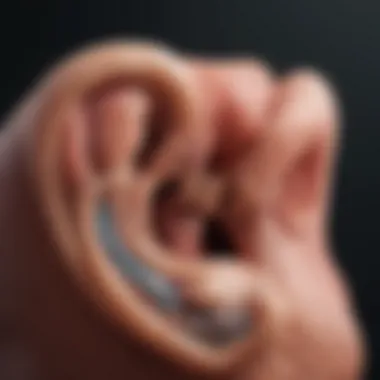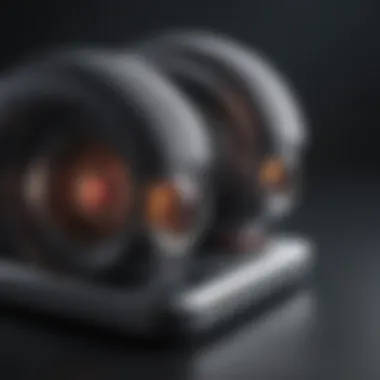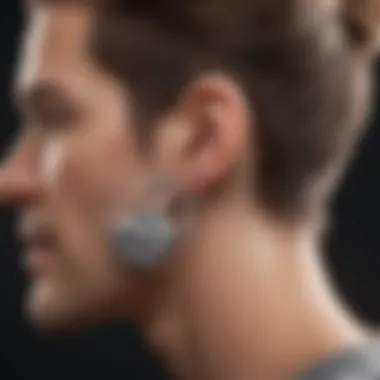Understanding Bilateral Sensorineural Hearing Loss


Intro
Sensorineural hearing loss (SNHL) presents significant challenges for many individuals. Often regarded as an all-too-common issue, it affects not just the ability to hear but also the way a person interacts with their environment and community. Think of it like trying to tune a radio, only to realize that the station is lost in static—that’s how some experience sound daily. Understanding SNHL, especially when it impacts both ears, is key to grasping its nuances and consequences.
This article will journey through the causes, diagnostics, and the cutting-edge treatments at our disposal today, such as hearing aids and cochlear implants. By digging deep into the current research and practices, we’ll spotlight the vital intersection of communication and quality of life for those with this condition, ensuring that we touch on the core issues and advances that could shape their experiences. Let's unravel this tangled web and shine a spotlight on SNHL.
Intro to Sensorineural Hearing Loss
Sensorineural hearing loss (SNHL) presents a complex web of challenges for many individuals, significantly altering their interactions with the world. The importance of understanding this auditory condition cannot be overstated, as it affects not just the ability to hear but also a person's overall quality of life. From the nuances of diagnosing the condition to the various treatment modalities available, every aspect warrants a detailed exploration.
In this article, we aim to unpack the specifics surrounding SNHL, starting from its definition to the broader implications it has on daily living. Recognizing the characteristics of this condition is crucial not only for medical professionals but also for patients and their families who navigate these waters daily.
The exploration of its epidemiology sheds light on how prevalent this condition is, informing public health discussions that could lead to better resources and support. The insights derived from such discussions can influence awareness campaigns, encourage early detection, and improve the effectiveness of interventions.
Moreover, understanding SNHL allows for a profound appreciation of the auditory system's complexity. Each ear may present unique signs of hearing loss, yet the bilateral aspect of this condition emphasizes the intertwined nature of auditory function. With factors spanning genetics, environmental influences, and age, various strands weave together to create individual experiences of hearing loss.
This comprehensive discussion on sensorineural hearing loss will help demystify the condition, fostering empathy and awareness while providing actionable insights into management and potential solutions. By detailing diagnostic procedures and treatment options available, we can empower individuals to seek the best possible care. After all, knowledge is indeed power, especially for those grappling with the implications of this condition.
Definition and Characteristics
Sensorineural hearing loss is specifically defined as damage to the inner ear or the nerve pathways from the inner ear to the brain. This definition holds significance, as it delineates the pathophysiological basis essential for understanding treatment approaches.
Characteristics of SNHL include:
- Difficulty in understanding speech, particularly in noisy environments
- A tendency to hear certain frequencies or pitches less clearly than others
- Often a gradual onset, which can lead to unnoticed progression
By pinpointing these characteristics, we can address the necessary considerations for diagnosis and management.
Epidemiology of SNHL
The epidemiology of sensorineural hearing loss reveals a striking picture of prevalence across various demographics. Statistical data indicate that around 1 in 1,000 children are born with SNHL, while the figures for adults increase significantly as age progresses. In fact, nearly 25% of adults aged 65 and older exhibit some degree of sensorineural hearing loss.
This segment of the population illustrates a crucial need for proactive assessment and intervention strategies.
Aside from age, other factors contribute to the prevalence of SNHL. Consideration of environmental exposures, such as noise pollution and ototoxic medications, highlights the importance of creating awareness about preventive measures.
"Understanding the epidemiology of sensorineural hearing loss allows us to prioritize research and health promotion efforts, ultimately striving for improved outcomes for affected individuals."
In summary, the effects of SNHL are extensive, influencing both individual lives and public health paradigms. Awareness and informed research will finally work toward effective strategies for treatment and management.
Anatomy of the Auditory System
Understanding the anatomy of the auditory system is crucial when delving into sensorineural hearing loss (SNHL), especially as it pertains to both ears. This intricate system serves as the body's way to interpret sound, and any dysfunction within its structures can lead to significant auditory challenges. The auditory system consists of three primary sections: the outer ear, middle ear, and inner ear. Each part plays an integral role in sound perception, and disturbances in any of these areas can result in varying degrees of hearing loss.
Outer Ear Structure
The outer ear is the first line of defense in the auditory process. Comprising the pinna and the external auditory canal, its main role is to funnel sound waves toward the eardrum. The shape of the pinna, often thought to be just for decoration, is actually designed to catch sound from various directions, aiding in sound localization, making it easier for the brain to pinpoint where a sound is coming from.
Moreover, the skin lining the external auditory canal is structured with hair follicles and glands that produce earwax. This waxy substance protects the ear canal from dust, debris, or any tiny organisms trying to sneak in. When functioning properly, the outer ear effectively prepares sound waves for their journey into the middle ear, emphasizing its importance in the hearing process.
Middle Ear Function
Transitioning from the outer ear, the middle ear consists of the eardrum and three tiny bones known collectively as the ossicles: the malleus, incus, and stapes. These bones are some of the smallest in the human body but play a pivotal role in amplifying sound vibrations from the eardrum before they reach the inner ear.


When sound waves hit the eardrum, it vibrates, creating movement in the ossicles. The stapes, the last of the three, interfaces with the oval window that leads into the inner ear. This anatomical setup allows for substantial amplification of sound—about twenty times more than what would be possible if sound merely traveled through air. This amplification is essential, as it facilitates efficient transmission of sound vibrations, ensuring they reach the inner ear intact and ready for further processing.
Inner Ear Mechanics
The inner ear houses the cochlea, a spiral-shaped organ containing fluid and tiny hair cells that transduce sound vibrations into electrical signals for the brain. Once the stapes pushes against the oval window, fluid within the cochlea moves, causing the hair cells to bend in response. This bending action generates nerve impulses that travel along the auditory nerve to the brain, where they are interpreted as sound.
The inner ear also contains the vestibular system, which contributes to balance, although this is outside the scope of hearing loss specifically. It's worth noting that any dysfunction in the inner ear's mechanics, such as damage to the hair cells from loud noise exposure or aging, can directly lead to bilateral sensorineural hearing loss. This underscores the significance of understanding both the intricate anatomy of the auditory system and the physiological processes essential for sound perception, as these are key to understanding the complexities of hearing loss.
Understanding these basic structures and their functions provides a rather comprehensive foundation for diagnosing and managing sensorineural hearing loss effectively.
Causes of Bilateral Sensorineural Hearing Loss
Understanding the causes of bilateral sensorineural hearing loss (SNHL) is crucial for grasping the complexities of this condition. SNHL arises when there is damage to the inner ear or the auditory nerve pathways to the brain. The etiology can be multifactorial, including both genetic and acquired influences. Identifying the roots of this condition is not only important for diagnosis but also has significant implications on treatment and management strategies. Gaining insight into these causes helps to pave the way for targeted interventions, ultimately enhancing the quality of life for those affected.
Genetic Factors
Genetic predispositions play an integral role in developing bilateral SNHL. Research indicates that around 50% of cases may have a hereditary component. Genetic alterations can be inherited in various patterns including autosomal dominant, autosomal recessive, and X-linked. A notable example is the GJB2 gene, often associated with nonsyndromic hearing loss.
The importance of pinpointing genetic causes cannot be overstated; it not only aids in understanding the familial risk for other family members but also provides options such as genetic counseling. This may guide families on the likelihood of passing the condition to their offspring, and in some cases, assist in early diagnosis and treatment.
Acquired Factors
Acquired factors encompass a wide array of external influences that can lead to SNHL. Exposure to loud noises over time can lead to noise-induced hearing loss, which is particularly rampant in certain occupations like construction or music. Viral infections such as meningitis can cause inflammation in the auditory pathways, leading to permanent hearing loss. Additionally, ototoxic drugs, typically prescribed for infections or cancer, can also contribute to hearing impairments.
Here are some common acquired factors:
- Noise Exposure: Continuous loud noise can damage hair cells in the cochlea.
- Infections: Diseases like cytomegalovirus or mumps can affect hearing.
- Ototoxic Medications: Some antibiotics or chemotherapy agents may be harmful to hearing.
- Head Trauma: Injuries can cause damage to the inner ear or auditory nerves.
Understanding these risk factors is pivotal, as it allows individuals to implement preventive measures. For example, using ear protection in loud environments can help mitigate the risk of noise-induced SNHL.
Age-Related Changes
Age-related hearing loss, also known as presbycusis, is a prevalent issue among older adults. As people age, the delicate structures of the inner ear undergo degeneration. This gradual deterioration affects the ability to perceive high-frequency sounds and can interfere significantly with speech comprehension.
- Cochlear Functionality: Deterioration of the cochlear hair cells leads to less effective sound processing.
- Ossicular Chain Changes: Alterations in the bones of the middle ear can also impair the transmission of sound.
- Auditory Nerve Efficacy: Reduced efficiency of the auditory nerve can complicate sound recognition and localization.
Moreover, environment interacts with aging. Noise exposure over the years accumulates, further exacerbating hearing loss. As a result, it becomes vital to monitor hearing as one ages, as early intervention may lead to better outcomes.
"The first step towards managing hearing loss begins with understanding its roots."
For further detailed reading, resources like Wikipedia and Britannica can provide additional insights.
Symptoms and Diagnosis
Understanding the symptoms and diagnosis of sensorineural hearing loss (SNHL) is pivotal for both patients and healthcare professionals. Recognizing the signs early can enable timely intervention and is essential in mitigating the adverse effects on communication abilities and overall well-being. This section elaborates on the common symptoms, the methodologies for clinical assessment, and the various audiometric testing procedures that are crucial in diagnosing this condition.
Common Symptoms
When it comes to sensorineural hearing loss, individuals often experience a range of symptoms that can vary in intensity. These manifestations often include:
- Difficulty understanding speech, especially in noisy environments. This can lead to frustrating situations when conversing with others.
- Muffled sounds, where even loud noises may not seem clear. This can make media consumption, like movies or music, challenging.
- Tinnitus, a ringing or buzzing sound in the ears, is often reported alongside hearing loss. This can exacerbate the difficulty of hearing external sounds.
- Volume inconsistencies in hearing, where some sounds may be louder or quieter than expected.
It’s crucial for individuals to be aware of these symptoms, as prompt recognition can aid in avoiding further complications or progression of hearing impairment.


Clinical Assessment
Clinical assessment plays a significant role in determining the presence and extent of SNHL. This often includes a thorough medical history review followed by a physical examination of the ear. Essential steps in the clinical assessment consist of:
- Patient Interviews: Discussing the onset, duration, and progression of symptoms helps shape a clearer understanding of the individual's condition.
- Family history: Any hereditary factors can provide essential context since some types of hearing loss are genetic.
- Medication Review: Certain medications are known to have ototoxic effects, contributing to hearing loss.
These steps enable professionals to differentiate between types of hearing loss and to rule out other potential causes such as middle ear issues or noise-induced damage.
Audiometric Testing Procedures
Audiometric testing is the cornerstone of diagnosing sensorineural hearing loss. Various procedures are used to obtain a comprehensive auditory profile, including:
- Pure Tone Audiometry: This test measures the faintest tones a person can hear at various frequencies. Both air conduction and bone conduction tests are performed.
- Speech Audiometry: In this process, an individual's ability to recognize speech is evaluated at different volume levels. It helps in understanding real-life listening capabilities.
- Impedance Audiometry: This tests the functionality of the middle ear. It measures how the eardrum responds to sound, which can indicate if there's a conductive component to the hearing loss.
Ultimately, the results of these tests guide professionals in tailoring an appropriate management plan. Each step in the diagnostic process is crucial in identifying the type and severity of the hearing loss and ensuring effective treatment strategies are employed.
Impact of Hearing Loss on Daily Life
The experience of bilateral sensorineural hearing loss significantly skews the daily lives of those affected. On a surface level, it may seem like a mere challenge to hear better, but the layers of its impact run much deeper. Understanding these aspects is essential for fostering awareness, empathy, and effective management strategies.
Communication Challenges
For individuals with bilateral sensorineural hearing loss, communication comes with hurdles that can feel insurmountable. Everyday interactions, be it with family or colleagues, may become frustrating. It's not just about not hearing the words clearly; often, it’s about missing nuanced sounds—little things like humor, intonation, or emotion that convey meaning.
In group settings, conversations can feel like a game of catch-up. Those affected frequently ask others to repeat themselves or strain to follow discussions. This constant re-engagement can lead to fatigue, which only fuels feelings of isolation.
- Common communication barriers include:
- These factors may lead one to withdraw from social settings—a cycle that further exacerbates loneliness and frustration.
- Difficulty following fast-paced dialogues.
- Trouble distinguishing voices in louder environments.
- Missed cues from body language or facial expressions.
Emotional and Psychological Effects
The emotional ramifications of living with sensorineural hearing loss are profound. Individuals often grapple with feelings of inadequacy, anxiety, and depression. Imagine feeling like you’re always on the outside looking in—while others share stories or jokes, you’re left piecing together fragments. This scenario can foster feelings of frustration and helplessness.
Research has shown a strong correlation between hearing loss and mental health issues. Noticing a pattern? Increased instances of anxiety disorders and depression often surface in those with compromised hearing abilities. Here’s some highlights:
- Increased feelings of sadness: The social withdrawal can lead to feelings of isolation.
- Lowered self-esteem: As the communication struggles amplify, self-confidence may diminish, creating a vicious cycle.
"Hearing loss is not just a sound issue; it's an emotional journey that affects the whole person."
Social Implications
The societal impact of bilateral sensorineural hearing loss transcends personal boundaries. Relationships suffer when communication is challenging, leading to misunderstandings and rifts within family and friendships. People might hesitate to invite you to gatherings, assuming the struggle will make it unpleasant for you. The reality is that severe hearing loss often creates a barrier to engaging in community events and social activities.
Here are a few social consequences that may arise:
- Alienation in social settings: The pressure to keep up leads to self-isolation.
- Changes in social dynamics: Friends may become frustrated or unsure about how to communicate effectively.
- Barriers to employment: In the workplace, opportunities may dwindle not just due to ability but also from perceptions of inadequacy.
Management and Treatment Approaches
The complexity of sensorineural hearing loss (SNHL) underscores the necessity for effective management and treatment strategies. Dealing with this condition isn't just about amplifying sound; it's also about enhancing the quality of life for individuals. SNHL can make daily communication a challenging feat, demanding innovative interventions to bridge the gap in auditory perception. Here, we delve into the main avenues for managing and treating SNHL, examining specific tools and their contributions to augmenting individual experiences.
Hearing Aids


Hearing aids are one of the most common treatment options for those affected by SNHL. These devices help amplify sounds and can be tailored to each individual's hearing profile, which highlights their versatility. Recent advancements have seen the development of programmable hearing aids that adjust in real-time to different sound environments, whether it’s a bustling café or a quiet room.
- Benefits of hearing aids include:
- Improved communication abilities in various settings
- Availability of wireless options, becoming even more user-friendly
- A chance to regain social interactions which might have been affected by hearing loss
However, it is important to consider that not every individual experiences the same level of improvement. Sometimes, the adjustment to them might feel overwhelming, as it involves retraining the brain to process sounds that have been missed for a while. Proper fitting and patient support are crucial for maximizing the effectiveness of hearing aids.
Cochlear Implants
Cochlear implants provide an alternative approach for individuals who receive limited benefits from traditional hearing aids. These surgically implanted devices bypass damaged portions of the ear and directly stimulate the auditory nerve. The process involves mapping the unique hearing profile of the user, ensuring tailored sound delivery, which can be incredibly life-altering for many. It's essential to note that the decision-making process for cochlear implants should include thorough discussions about potential outcomes and realistic expectations.
- Key Considerations include:
- Not all individuals qualify; candidacy is usually dependent on the degree of hearing loss and prior hearing experiences
- The rehabilitation process post-implantation can be extensive and requires commitment from the user
- Long-term tracking and support are vital for sustaining desired outcomes
Cochlear implants do not magically restore hearing; rather, they provide a different acoustic experience, enabling many to reclaim conversations and enrich their social experience.
Auditory Rehabilitation Programs
Auditory rehabilitation programs are crucial adjuncts in the journey towards effective hearing management. These programs typically go beyond just fitting devices; they encompass training and support tailored to the unique needs of the individual experiencing hearing loss. Through guided practices, participants can improve their listening skills, learn effective communication strategies, and adapt to their altered auditory landscapes.
- Components of such programs often include:
- Auditory Training: Exercises that enhance the ability to recognize sounds and speech despite background noise
- Counseling: Addressing the psychological aspects of adapting to hearing loss, which can help mitigate feelings of isolation or anxiety
- Family Involvement: Educating families on how to communicate more effectively with their loved ones who have hearing impairments
"Auditory rehabilitation is not a one-size-fits-all solution but a journey tailored to the unique auditory profile and lifestyle of the participant."
When integrated into an overall management plan, auditory rehabilitation serves to maximize the benefits of hearing aids or cochlear implants, making the entire experience more realistic and fulfilling.
Overall, the combination of hearing aids, cochlear implants, and auditory rehabilitation showcases a holistic approach to addressing the multi-faceted challenges posed by sensorineural hearing loss. Each strategy carries its benefits and considerations, allowing healthcare professionals to tailor management plans to best suit individual needs.
Future Directions in Research
Research in sensorineural hearing loss (SNHL) is evolving rapidly, leading to exciting new prospects that could significantly change the landscape of diagnosis and treatment. The future is not just limited to improving existing practices but also exploring innovative methodologies and technologies that hold the potential to enhance the lives of individuals affected by this condition. This section emphasizes the critical importance of progress in SNHL research, focusing on emerging therapies, the role of genetic studies, and their implications for better treatment outcomes.
Emerging Therapies and Technologies
There’s no denying that advancements in technology are paving the way for novel therapeutic approaches to tackle SNHL. Recent studies have unearthed a plethora of promising techniques that could transform how we understand and manage hearing loss.
- Gene Therapy: This is one of the most anticipated developments in the field. By targeting specific genes, researchers aim to correct mutations that lead to hearing loss.
Culmination
The exploration of sensorineural hearing loss in both ears is paramount for multiple reasons. Hearing loss, particularly when bilateral, can drastically affect an individual's life. Understanding the nuances of this condition enables better diagnosis and management, leading to improved outcomes for those affected. The essence of this article underscores the need to comprehend not only the medical and physiological aspects but also the social and emotional implications associated with this type of hearing loss.
Summary of Key Insights
In reviewing sensorineural hearing loss, several key insights come to the forefront:
- Prevalence: SNHL is not just an individual concern, but a widespread condition affecting a significant portion of the population, making awareness critical.
- Diverse Etiologies: The causes can range from genetic factors to environmental influences, which necessitates personalized approaches to treatment.
- Modern Treatment Options: Advances in medical technology have paved the way for varied management strategies, including hearing aids and cochlear implants, thus providing hope for patients.
- Impact on Life Quality: The implications of hearing loss stretch far beyond just difficulty in hearing; they can affect communication, relationships, and emotional well-being.
By synthesizing this information, we can cultivate a deeper understanding of sensorineural hearing loss and recognize the importance of timely intervention and support for those affected by this auditory condition.
Importance of Awareness and Advocacy
Awareness and advocacy are integral in the context of sensorineural hearing loss. Not only does it help reduce stigma surrounding the condition, but it also fosters an environment where individuals feel empowered to seek help.
- Increasing Public Knowledge: Raising awareness about SNHL can lead to early detection and intervention, which are essential for mitigating the condition’s long-term effects.
- Support Networks: Advocacy efforts often establish support groups, providing platforms for sharing experiences and coping strategies.
- Policy Changes: Greater awareness can drive policy changes that ensure better access to audiological services and support for individuals affected by hearing loss.
As we navigate through the complexities of sensorineural hearing loss, it becomes evident that education and advocacy are not just supplementary; they are fundamental to enhancing the lives of those impacted. The more informed society is, the more effective measures can be taken to support individuals in their journey through hearing loss.















